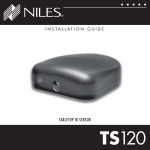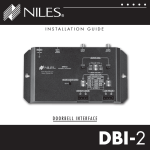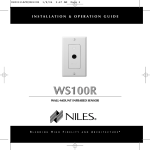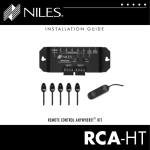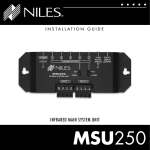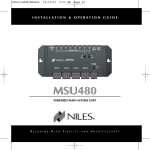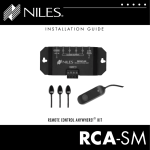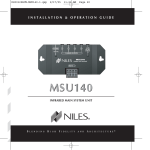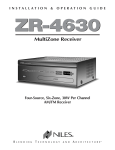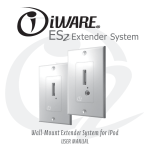Download Niles Audio TS100 User's Manual
Transcript
DS00326ACN/TS100 11/26/03 11:58 AM Page 2 I N S TA L L AT I O N & O P E R AT I O N G U I D E TS100 TABLE-TOP INFRARED SENSOR B L E N D I N G H I G H F I D E L I T Y A N D A R C H I T E C T U R E ® DS00326ACN/TS100 11/26/03 TA B L E - 11:58 AM T O P I Page 3 N F R A R E D R E M O T E S E N S O R TS100 Table-top Infrared Remote Sensor Introduction TABLE OF CONTENTS Introduction 1 Features and Benefits 2 Installation Considerations 3 Installation 7 Operation 8 Troubleshooting 9 Specifications 12 Contents 12 The TS100 is a tabletop, infrared sensor designed for use with the Niles infrared extender systems. Installed in a remote room location, the TS100 receives the IR commands transmitted from your hand-held remote(s). The IR commands are carried via a category 5 cable to your A/V equipment in another room, and instantly “repeated”. The TS100 represents one of the 3 building blocks necessary to complete a Niles IR repeating system: • IR Main System Unit—Models MSU140, MSU250, MSU480 and MSU440Z. • IR Sensors/Keypads—Models WS100, TS100, MS100, MVC100IR, MS200, CS100 and the IntelliPad®. • IR Flashers—Models MF1, MF1VF, MF2, MF2VF and the IRB1. An IR sensor expansion unit, Model IRH610, is available for IR repeater systems used in more than six rooms. DS00326ACN/TS100 11/26/03 TA B L E - 11:58 AM T O P I Page 4 N F R A R E D R E M O T E S E N S O R Features and Benefits The TS100 offers a number of improvements over other table-top IR sensors. • Plasma-proof performance—allows placement of the TS100 near plasma displays. • CFL interference resistant—expands installation flexibility to areas with fluorescent lighting. • Works under most lighting conditions, including indirect sunlight—eliminates environmental restrictions. • Universal system—compatible with virtually all brands of A/V equipment and remote controls. • Excellent IR receiving range—you get 18' to 30' of remote control range (depending upon the strength of your handheld remote). • 100% factory tested for pickup range and angle. • Small size of only 2-7/8" wide x 1-1/16" high x 3-1/8 deep— fits almost anywhere. • Printed circuit board design uses surface mount technology (SMT), assuring high reliability. • Ideal for both home and commercial installations. • Non-skid, non-scratch feet. • Two year parts and labor warranty. 2 DS00326ACN/TS100 11/26/03 TA B L E ”Tech Tip“ Wire size is expressed by it's AWG (American Wire Gauge) number. The lower the AWG number, the larger the wire, i.e., 20 AWG wire is physically larger than 22 AWG. - 11:58 AM T O P I Page 5 N F R A R E D R E M O T E S E N S O R Installation Considerations Type of Cable The TS100 connects to the Niles infrared main system unit or IRH610 sensor expansion hub with an individual home run of category 5 cable. When running wires inside walls, most states and municipalities in the U.S. specify that you must use a special type of wire. Usually, the requirement is that the wire has a specific “CL” fire rating, such as “CL-2” or “CL-3”. Consult your Niles dealer, building contractor, or local building and inspection department if unsure about which type of wire is best for your application. MS100 Mounting Location The TS100 is ideal for use in applications when ceiling or wallmounting is undesirable. Its small size and unobtrusive appearance makes it ideal for installation in existing homes or cabinets with great ease and minimal custom work. Installing the TS100 close to the primary location of the user will ensure best performance. The TS100 is designed to mount over or under almost any flat horizontal surface. Convenient mounting locations for the TS100 are: • On top of a television set • On a shelf in an entertaiment center • Under a shelf in an entertanment center Receiving Range and Pickup Angle The receiving range of the TS100 will vary according to the IR output strength of the remote control being used. Remote strength varies among brands depending on the number and 3 DS00326ACN/TS100 11/26/03 TA B L E - 11:58 AM T O P I Page 6 N F R A R E D R E M O T E S E N S O R Niles IR flasher 12V DC power supply (supplied with the MSU250 IR main system unit) plugged into an unswitched AC outlet powers the system Stereo receiver 12V DC power supply (not supplied, Niles stock# FG00665) plugged into the switched outlet MSU250 Bi-colored LED Removable connector pins Power, IR data, and power status signal via category 5 wire TS100 IR sensor Figure 1 Parts guide. Figure 2 Connecting the TS100 to a Niles MSU250 IR main system unit broadcasting a status feedback signal. 4 DS00326ACN/TS100 11/26/03 TA B L E - 11:58 AM T O P I Page 7 N F R A R E D R E M O T E S E N S O R size of batteries used, and how many IR emitters the remote has. For example, remotes that operate on two small AAA batteries and have only one IR emitter are generally not as strong as remotes that use the larger AA size batteries and have two emitters. Tests with various manufacturers’ remote controls have shown that the operating range can vary from a minimum of 20' to a maximum of about 30'. Infrared signals travel essentially line-of-sight. They will not pass through or around solid objects. Do not rely on an IR signal being able to “bounce” off a wall or object to the MS100. The IR pickup angle of the TS100 is 30° off-axis (horizontal and vertical) at 20'. Avoiding Electrical Interference Avoid locating the TS100 near any potential sources of electrical or optical noise, such as light dimmers, low-voltage lights, and neon lights. Avoiding Optical Feedback If installing the TS100 in the same room as an IR flasher, it is possible for the flasher’s IR output to be picked-up by the TS100. This effect, known as an optical feedback loop, can cause erratic operation. Optical feedback is similar to acoustical feedback: the howling or whistling sound heard in a P.A. system when the microphone is too close to the speaker. To avoid optical feedback: 1. Re-position the flasher(s) and/or the sensor. 2. Use Niles MF series flashers and cover them with the supplied IR blockers. 5 DS00326ACN/TS100 11/26/03 TA B L E - 11:58 AM T O P I Page 8 N F R A R E D R E M O T E S E N S O R Avoiding Interference TS100 is designed to work in most applications including plasma TV’s and in areas where CFL lighting and indirect sunight are present. You should avoid locating the TS100 near potential sources of electrical or optical noise, such as light dimmers or low-voltage lights. Using the Power Status Display The Green power status LED can only be activated by a “power status” broadcast from a Niles IR main system unit (MSU140, MSU250, MSU480, MSU440Z). The IR main system unit will broadcast the power status signal if the preamp/ receiver is on and a 12V DC adapter is plugged into the preamp/receiver’s switched AC outlet and the 3.5mm plug is connected to the IR main system unit’s Status input jack. (Figure 2). Note: The 12V DC adapter plugged into the switched outlet of the stereo receiver is not included with the IR main system unit. It should be 12V DC with a minimum of 100mA of output. It can be ordered from your Niles dealer (FG00665 power adaptor). Using the TS100 with the Intellipad Ci system. The TS100 is fully compatible with the Niles Intellipad Ci line, follow the wiring instructions in Figure 4. For specific information see your Intellipad Ci manual. 6 DS00326ACN/TS100 11/26/03 TA B L E - 11:58 AM T O P I Page 9 N F R A R E D R E M O T E S E N S O R Installation Step by Step 1. The TS100 is a small free-standing box designed to sit on a shelf or other convenient surface. The unit can be mounted under a shelf using double-sided tape or Velcro® (not supplied). 2. Run the cable to the TS100. Label the cable for future reference. 3. Locate the connector on the TS100 and remove it. 4. Next, strip 1/4" of insulation from the end of each wire. Tightly twist the end of each wire until there are no frayed ends. 5. Use a small flathead screwdriver or your thumbnail to raise the locking tabs, exposing the holes on the removable connectors. 1 = Green/White - 12V 2 = Green - DATA 3 = Orange/White - GROUND 4 = Blue - EMPTY 5 = Blue/White - STATUS 6 = Orange - EMPTY 7 = Brown/White - EMPTY 8 = Brown - EMPTY Tab Down 5 = STATUS 3 = GROUND 1 = STATUS 2 = DATA 3 = GROUND 4 = 12V DC 1 = 12V 2 = DATA Figure 4 This color code is based on the industry standard T568A coding for the RJ45 connector. When connecting the TS100 to the Niles Ci system observe this pin configuration 7 DS00326ACN/TS100 11/26/03 TA B L E - 11:58 AM T O P I Page 10 N F R A R E D R E M O T E S E N S O R 6. Insert each wire into the appropriate hole on the removable connector plug (Figure 6), and snap the locking tab down. To help you, the connector plug is keyed. Insert the smooth side of the connector plug into the smooth side of the socket. Don’t force the scalloped side of the connector plug into the smooth side of the socket (Figure 5). 7. Double-check all connections. Plug the connector back into its socket on the TS100. Operation Operation of the TS100 is simple. Stand within the operational range of your TS100, aim your hand-held remote at the TS100 and press the button for the desired command. Your IR command is instantly repeated to your A/V equipment. Figure 5 Installing the removable connector. 1 = STATUS 2 = DATA 3 = GROUN 4 = 12V DC Green “Power Status” LED When the TS100 is correctly connected (Figure 2), the Green LED will stay lit as long as the preamp/receiver is on. When your preamp/receiver is off, the LED will stay off. Blue “Flashback” LED The blue “flash-back” LED on the TS100 visually confirms the reception of an IR command. Figure 6 8 DS00326ACN/TS100 11/26/03 TA B L E - 11:58 AM T O P I Page 11 N F R A R E D R E M O T E S E N S O R Troubleshooting This manual contains instructions for the TS100 only. For specific information on the adjustment and operation of your Niles infrared extender system, please refer to the instruction manual included with your Niles IR Main System Unit (MSU140, MSU250, MSU480 MSU440Z, IntelliControl). The bi-color blue/green LED on the front of the TS100 is a useful troubleshooting aid. The blue LED should light only when a remote command is being received. If the LED on the TS100 “flickers”, and the TS100 functions normally, there is no cause for concern, some stray IR signal are being received by the TS100 but are not being repeated. 1. Test the remote control(s) by operating the A/V equipment directly. Replace the batteries if needed. 2. Double check the cable connections on all TS100’s and on the main system unit. Look for open, shorted or reversed wires. 3. Test for interference from the following sources: • Neon or halogen lights in the room • Light dimmers, beginning with those closest to the TS100 Observe the TS100’s LED while performing all the tests. It is possible to have interference from more than one source. 9 DS00326ACN/TS100 11/26/03 TA B L E - 11:58 AM T O P I Page 12 N F R A R E D R E M O T E S E N S O R Eliminating Optical feedback In some installations, two conditions combine to create an optical feedback loop. Symptoms can include: poor range, intermittent operation or no operation. The conditions which sometimes combine to create a feedback loop are: 1. Both a sensor and a flasher are located within the same room. 2. There is some low-level noise or interference on your system. You can eliminate optical feedback by replacing any IRB1 “flooding flasher” with MF1 or MF2 MicroFlashers and covering all flashers with the supplied IR blocking covers. Identifying the Type of Interference The blue “flash-back” LED on the front of the TS100 is a useful trouble-shooting aid. The LED should light blue only when a remote command is being received. However, if the LED on the TS100 “flickers”, and the TS100 functions normally, there is no cause for concern. If the TS100 does not work, and the LED does not light at all: Test the remote control(s) by operating the A/V equipment directly. Replace the batteries if needed. Double check the cable connections on the TS100’s and on the IR main system unit. Consult your IR main system unit’s manual for more detail. 10 DS00326ACN/TS100 11/26/03 TA B L E - 11:58 AM T O P I Page 13 N F R A R E D R E M O T E S E N S O R If the TS100 does not work, and the LED “flickers” or remains solidly lit: Cover up the Sensor with a piece of cardboard (your hand will actually create electromagnetic interference under some conditions). Observe the IR test LED. IR Test LED Off: Optical Interference IR Test LED On or Flickering: Electromagnetic Interference EMI (Electromagnetic Interference) Identify the source of the interference. The most common sources of electromagnetic interference are listed in the Installation Considerations section on pages 5 and 6. To eliminate EMI try the following methods: 1. Move the sensor or the sensor cable away from the EMI source or move the source of the EMI away from the sensor or the cable. 2. Connect the Sensor’s GND terminal to true earth ground (if this isn’t feasible use the main system unit’s GND terminal). There are many methods for reducing interference. Which solution is best for you depends on your situation. Contact Niles Technical Support at 1-800-289-4434 if you require further assistance. 11 DS00326ACN/TS100 11/26/03 TA B L E - 11:58 AM T O P Specifications IR System Compatible with virtually all brands of remotes using carrier frequencies between 26 and 105 kHz IR Receiving Range 18' to 30' depending upon the strength of the remote control I Page 14 N F R A R E D R E M O T E S E N S O R Unit Dimensions 2-7/8" wide x 1-1/16" high x 3-1/8" deep Contents TS100 x1 Removable connector x 1 IR Receiving Angle 30° off-axis (horizontal and vertical) at 20' Mounting Table-top Wiring Requirements Individual “home-runs” of category 5 cable “TECH NOTE” The feedback led can be disabled if it continues to flicker or visual feedback is not desired. Discrete on and off IR commands are available on the Niles Technical support website for disabling the feedback led. The address is: nilesaudio.com/techsupport. 12 DS00326ACN/TS100 11/26/03 TA Notes 13 B L E - 11:58 AM T O P I Page 15 N F R A R E D R E M O T E S E N S O R DS00326ACN/TS100 11/26/03 TA B L E - 11:58 AM T O P I Page 16 N F R A R E D R E M O T E S E N S O R Notes 14 DS00326ACN/TS100 11/26/03 11:58 AM Page 1 Niles Audio Corporation www.nilesaudio.com 12331 S.W. 130 Street Miami, Florida, 33186 Tel: (305) 238-4373 Fax: (305) 238-0185 ©2004 Niles Audio Corporation. All rights reserved. Niles, the Niles logo, IntelliControl, IntelliPad and Blending High Fidelity and Architecture are registered trademarks of Niles Audio Corporation. Because we strive to improve our products, Niles reserves the right to change product specifications without notice. The technical and other information contained herein is not intended to set forth all technical and other specifications of Niles products. Additional information can be obtained on-line at www.nilesaudio.com or by calling Niles at 1-800-289-4434. 01/04 Printed in China DS00326ACN
















